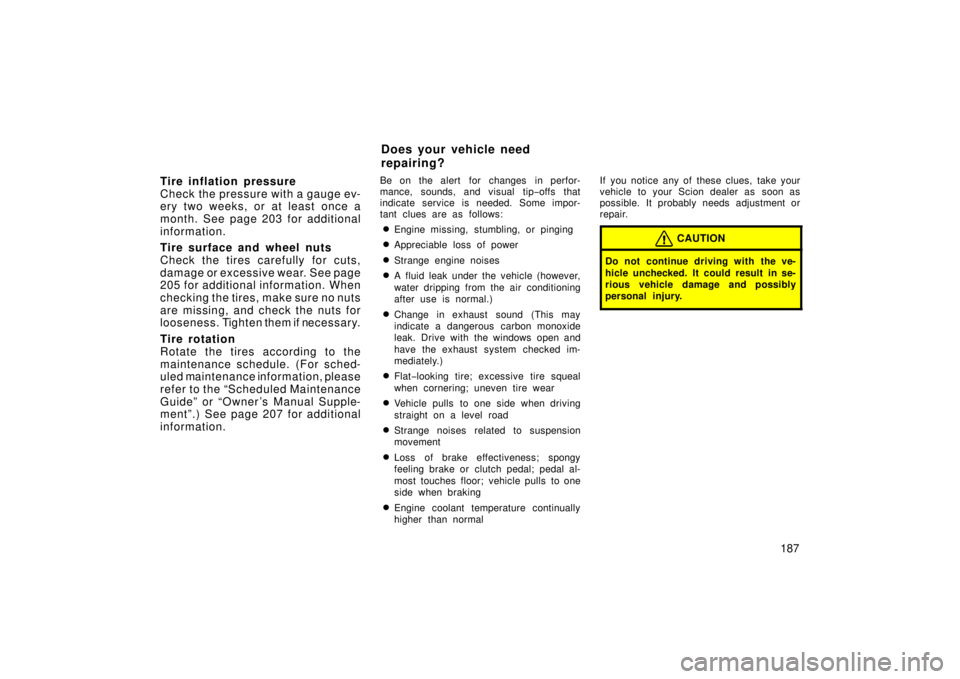Page 195 of 244

187
Tire inflation pressure
Check the pressure with a gauge ev-
ery two weeks, or at least once a
month. See page 203 for additional
information.
Tire surface and wheel nuts
Check the tires carefully for cuts,
damage or excessive wear. See page
205 for additional information. When
checking the tires, make sure no nuts
are missing, and check the nuts for
looseness. Tighten them if necessary.
Tire rotation
Rotate the tires
according to the
maintenance schedule. (For sched-
uled maintenance information, please
refer to the “Scheduled Maintenance
Guide” or “Owner ’s Manual Supple-
ment”.) See page 207 for additional
information.
Be on the alert for changes in perfor-
mance, sounds, and visual tip −offs that
indicate service is needed. Some impor-
tant clues are as follows:
�Engine missing, stumbling, or pinging
�Appreciable loss of power
�Strange engine noises
�A fluid leak under the vehicle (however,
water dripping from the air conditioning
after use is normal.)
�Change in exhaust sound (This may
indicate a dangerous carbon monoxide
leak. Drive with the windows open and
have the exhaust system checked im-
mediately.)
�Flat −looking tire; excessive tire squeal
when cornering; uneven tire wear
�Vehicle pulls to one side when driving
straight on a level road
�Strange noises related to suspension
movement
�Loss of brake effectiveness; spongy
feeling brake or clutch pedal; pedal al-
most touches floor; vehicle pulls to one
side when braking
�Engine coolant temperature continually
higher than normal If you notice any of these clues, take your
vehicle to your Scion dealer as soon as
possible. It probably needs adjustment or
repair.
CAUTION
Do not continue driving with the ve-
hicle unchecked. It could result in se-
rious vehicle damage and possibly
personal injury.
Does your vehicle need
repairing?
Page 200 of 244

192
CAUTION
�When the engine is running, keep
hands, clothing, and tools away
from the moving fan and engine
drive belts. (Removing rings,
watches, and ties is advisable.)
�Right after driving, the engine
compartment—the engine, radiator,
exhaust manifold and spark plug
boots, etc.—will be hot. So be care-
ful not to touch them. Oil, fluids
and spark plugs may also be hot.
�If the engine is hot, do not remove
the radiator cap or loosen the drain
plugs to prevent burning yourself.
�Do not leave anything that may
burn easily, such as paper or rags,
in the engine compartment.
�Do not smoke, cause sparks or al-
low open flames around fuel or the
battery. Their fumes are flammable.
�Be extremely cautious when work-
ing on the battery. It contains poi-
sonous and corrosive sulfuric acid.
�Do not get under your vehicle with
just the body jack supporting it. Al-
ways use automotive jack stands or
other solid supports.
�Be sure that the ignition is off if
you work near the electric cooling
fans or radiator grille. With the
ignition on, the electric cooling fans
will automatically start to run if the
engine coolant temperature is high
and/or the air conditioning is on.
�Use eye protection whenever you
work on or under your vehicle
where you may be exposed to flying
or falling material, fluid spray, etc.
�Used engine oil contains potentially
harmful contaminants which may
cause skin disorders such as in-
flammation or skin cancer, so care
should be taken to avoid prolonged
and repeated contact with it. To re-
move used engine oil from your
skin, wash thoroughly with soap
and water.
�Do not leave used oil within the
reach of children.
�Dispose of used oil and filter only
in a safe and acceptable manner.
Do not dispose of used oil and fil-
ter in household trash, in sewers or
onto the ground. Call your dealer or
a service station for information
concerning recycling or disposal.
�Take care when filling the brake and
clutch reservoirs because brake or
clutch fluid can harm your hands or
eyes. If fluid gets on your hands or
in your eyes, flush the affected area
with clean water immediately. If you
still feel uncomfortable with your
hands or eyes, go to the doctor.
Page 236 of 244

228
Fuses
81A001
Engine compartment
Fuses1. RDI 30 A: Electric cooling fan
2. HTR SUB1 50 A: Air conditioning sys-
tem
3. ABS NO.1 40 A: Anti−lock brake sys-
tem
4. DOME 15 A: Clock, interior light,
gauges of meters
5. EFI 15 A: Multiport fuel injection sys-
tem/sequential multiport fuel injection
system
81A002a
Instrument panel
6. HORN 15 A: Horn
7. AM2 15 A: Starter system, SRS airbag
system, multiport fuel injection sys-
tem/sequential multiport fuel injection
system, discharge warning system
8. ST 30 A: Starter system
9. H�LP LH/H�LP LO LH 10 A: Left−
hand headlight
10. H�LP RH/H�LP LO RH 10 A: Right−
hand headlight
11. A/C2 7.5 A: Air conditioning system 12. SPARE 30 A:
Spare
13. SPARE 15 A: Spare
14. AM1 50 A: “ACC”, “GAUGE”, “WIPER”,
and “ECU −IG” fuses
15. POWER 30 A: Power windows
16. HTR 40 A: Air conditioning system
17. GAUGE 10 A: Back−up lights, charging
system, air c onditioning system, power
window system, gauges of meters
18. DEF 25 A: Rear window defogger sys-
tem.
19. D/L 25 A: Power door lock system
20. TAIL 10 A: Tail lights, parking lights,
license plate lights
21. WIPER 25 A: Windshield wipers and
washer
22. ECU�B 7.5 A: SRS airbag system
23. FOG 15 A: Front fog lights
24. ACC 15 A: Clock, cigarette lighter
25. ECU�IG 7.5 A: Anti−lock brake system,
electric cooling fan
26. OBD 7.5 A: On−board diagnosis sys-
tem
Page 237 of 244
229
27. HAZ 10 A: Turn signal lights, emergen-
cy flashers
28. A.C 7.5 A: Air conditioning system
29. STOP 10 A: Stop lights, high mounted
stop light, anti −lock brake system, shift
lock system, multiport fuel injection
system/s equential multiport fuel injec-
tion system
Page:
< prev 1-8 9-16 17-24